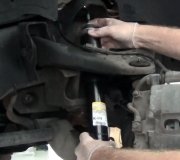One of two things has likely happened. In a real hard hit, the left rear strut could be bent. In the case of a pothole, the better suspect is the alignment adjustment has shifted. A standard four-wheel alignment will take care of that.
GM ships their cars from the factory not adjustable for "camber". That's the inward or outward tilt of the wheels as viewed from in front of the car. As the springs sag with age, and suspension parts wear, alignment angles change and need to be adjusted during the alignment. The first time a wheel needs to have camber adjusted, the mechanic has to grind the hole with the red arrow oblong so that mounting bolt can slide back and forth. That's how camber is adjusted on this model and those of many other manufacturers.
Around this time period, Chrysler used special bolts with off-center heads that made precise adjustment real easy, and those heads helped to hold the adjustment from slipping. GM's struts don't use those bolts. The only thing that holds the alignment is the clamping force of the two bolts. Normally that is sufficient as long as the mechanic tightens them enough, but it's still possible for the adjustment to shift during a hard impact.
If the rear struts have ever been replaced, many of those replacements come with the lower bolt hole already elongated. Some of them also have raised lips by my red arrow that allows for the special bolts to be used. Many mechanics don't use them in an effort to save their customers a little money, but when they are available, their cost is reasonable, especially if they prevent this from happening again.
,
Start by visiting a tire and alignment shop. They'll perform a steering and suspension system inspection. If no defective parts are found, the alignment should solve the tipped wheel.
Image (Click to make bigger)
Wednesday, December 22nd, 2021 AT 9:59 AM




